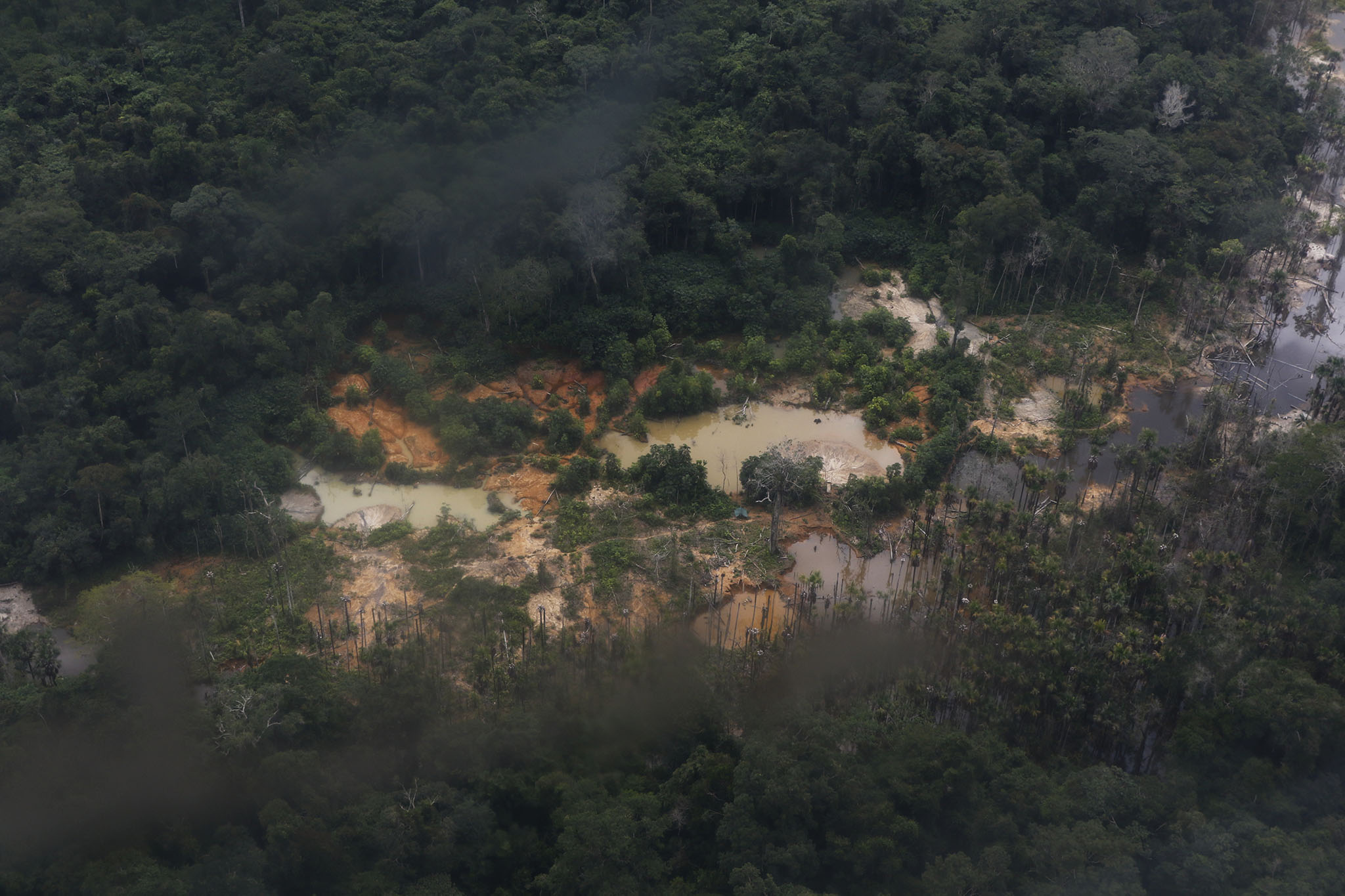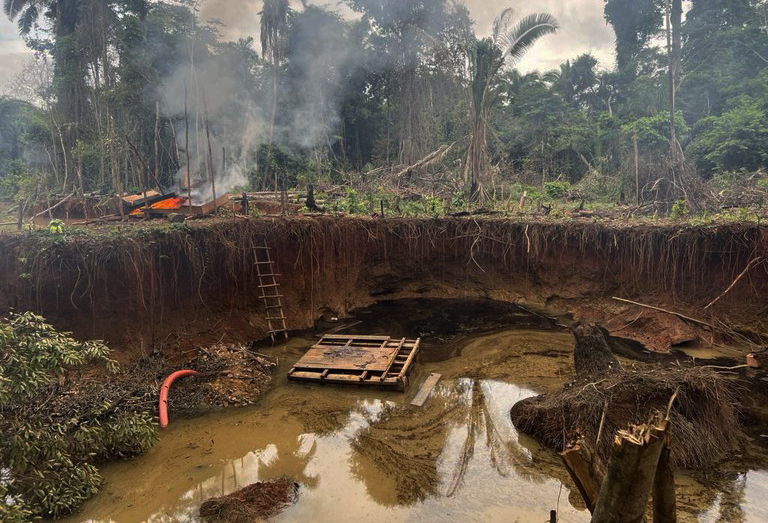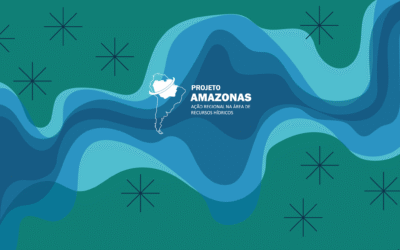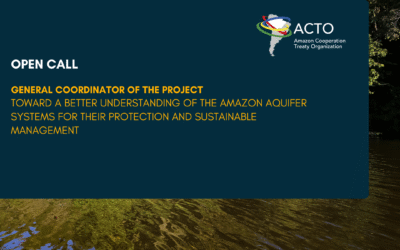The world’s largest river basin is threatened by mercury contamination. Among the nine transboundary problems considered a priority by the eight Amazonian countries, water contamination is considered the most serious. According to the United Nations Environment Programme (UNEP), mercury from artisanal and small-scale gold mining (ASGM) is one of the main pollutants in rivers and poses a significant threat to biodiversity, aquatic ecosystems and the health of the population, as well as producing unfavorable socio-economic impacts.
Despite the legislation in force in the countries of the region, illegal and informal gold mining in the Amazon Basin has increased over the last two decades. The pollution caused by illegal mining, by contaminating rivers and fish, has disproportionately affected indigenous peoples and riverside communities, impacting the food security of these populations, who depend on fishing as a source of subsistence.
- Illegal mining areas in Yanomami Indigenous Land, Brazil (Photo: Fernando Frazão)
- Illegal mining in Parauapebas, Brazil (Photo: Federal Police)
The increase in records of environmental pollution and human contamination and intoxication means that the Amazon countries urgently need to implement public policies to monitor and control the use and movement of mercury in the Amazon Basin, in compliance with the Minamata Convention, to which they are all signatories. To stimulate and support the development of these policies, the Amazon Basin Project (ACTO/GEF/UNEP), which implements the Strategic Actions Program for the Integrated Management of Water Resources in the region, is developing the Panorama on Mercury Contamination in the Amazon Region, a scientific study to quantify the sources of emissions and releases, according to the Mercury Inventory Toolkit developed by UNEP in 2013, and to identify areas of risk and vulnerability to contamination.
Carried out in partnership with the IRD (Institut de Recherche pour le Développement), a French research and teaching institution, the Amazon mercury panorama is being developed based on georeferencing mercury sources and quantifying the volume of emissions and releases. When completed, it will be incorporated into the Amazon Regional Observatory (ARO), ACTO’s Amazon Information Reference Center.
According to Professor Jeremie Garnier, one of the researchers responsible for the study, the current stage in the development of the panorama is producing a georeferenced inventory based on government and non-governmental organization data on the potential sources of mercury emissions.
“As far as possible, the potential sources of mercury are being verified using satellite images in order to prove the existence of the activity responsible for the supposed emission, observing predictive variables such as changes in land use and occupation to delimit the areas where there is a greater likelihood of finding anthropogenic mercury, that resulting from human activities,” explains Garnier.
The georeferenced information will be made available on ARO, according to the platform’s specifications, and presented to the countries during an event to be organized soon by the Amazon Cooperation Treaty Organization (ACTO). On that occasion, methods and procedures will be agreed for the next stage, which is the comprehensive quantification of the volume of total mercury emissions and releases in the Amazon Basin, using the Mercury Inventory Toolkit.
According to Garnier, georeferenced and quantified data will provide estimates that are closer to the reality of mercury contamination in the region, since existing assessments, even those produced for official documents in accordance with the Minamata Convention, are limited to identifying the main national sources of pollution without specifying emissions in the Amazon Basin area. Given this lack of regional estimates, the initial Minamata Convention Assessments (MIAs) conducted by the countries indicate the need for more research to better understand the extent of the mercury problem in the Amazon, a gap that the Amazon Basin Project/ACTO-IRD partnership seeks to overcome.
The mercury cycle and the metal’s presence in the Amazon
The preliminary report on the process of preparing the Panorama on Mercury Contamination in the Amazon Region, presented recently by researchers Jeremie Garnier and Henrique Roig, describes the origins and cycle of mercury and provides information on the natural and anthropogenic mercury present in the Amazon. This information will be included in the regional panorama in order to sensitize and make governmental and non-governmental institutions and civil society aware of the danger of this metal and the need to monitor and control its use.
According to the report, mercury comes from various sources, both natural and anthropogenic. Among the natural sources are erosion processes and volcanic eruptions, which release small amounts of mercury into the water and soil. Anthropogenic sources include mining, farming, the medical and dental industry, the energy sector and others. The multiple industrial and technological uses of mercury show the metal’s relevance to modern life.
Geologically ancient tropical environments, where soil formation is more intense, such as the Amazon, may be richer in natural mercury. Anthropogenic activities such as deforestation, farming and burning of large areas of forest are significant sources of release of natural mercury accumulated and stored in the soil.
With no known biological function, mercury circulates in the environment in a complex way, both in liquid, solid and gaseous form, engaging in oxidation and methylation processes that can result in highly toxic biochemical conversions, the most significant of which is methylmercury.
When released during the gold extraction process, mercury can be transported through the air, traveling great distances and contaminating soils and watercourses through dry or wet deposition during precipitation. Emissions from mining also occur through waste dumped on land and in bodies of water. Whether transported through the air or deposited in water and soil, mercury emissions represent a significant risk to environmental and human health, contaminating mainly communities in the vicinity of the areas occupied by mining, but also riverside communities and populations in distant towns.
“The metal’s cycling pathways, given their complexity, make it difficult to locate contaminated areas, even when it is possible to locate the emission points,” explains Professor Garnier.
- Illegal mining in the Javari Valley, Brazil (Photo: Ibama)
- Mining in operation in Conservation Units in Pará, Brazil (Photo: Ibama)
The first consolidated regional data
Based on the national data reported in the initial Minamata Convention Assessments (MIAs) and the National Action Plans (NAPs), the research team has consolidated in its preliminary report the first regional information on the areas most affected by mercury from mining and also on the environmental, socio-economic and human health impacts.
The scientific studies and the information contained in the MIAs and NAPs show high levels of mercury in samples of fish, soil and sediments and in the bodies of indigenous peoples and riverside communities in the cities of Beni and Pando (Bolivia), Madre de Dios (Peru), Chocó (Colombia), Napo and Zamora (Ecuador) and in the Guiana Shield, a region that also includes Suriname. Mining is intense in all of them.
In addition, the information contained in the MIAs and consolidated by the researchers shows that the main consequences of mercury contamination in the Amazon region are the environmental degradation of aquatic ecosystems, which makes water resources unfit for human consumption, as well as the degradation of soil and biota and impacts on the health of the population.
Mercury emissions from mining contribute to the pollution of ecosystems and other environmental effects, such as climate change associated with deforestation and soil erosion, which cause an increase in atmospheric concentrations of greenhouse gases. Records show that these environmental impacts have a lasting effect.
With regard to the consequences of mercury contamination on the health of Amazonian populations, scientific studies and MIAs mention damage to the central nervous system, such as loss of coordination and motor balance, kidney, cardiovascular and immune disorders, impaired vision and the respiratory system. The high levels of mercury in pregnant women, the national assessments point out, have damaged the development of fetuses and compromised the cognitive function and motor skills of babies, as well as their sensory perception.
The social impacts listed by the Amazon countries concern the displacement of communities, the loss of cultural heritage, as well as conflicts involving mining communities and other stakeholders.
The MIAs also address the market and supply of mercury in the Amazon. According to the data compiled by the Project, the Amazonian countries do not produce mercury at significant levels and therefore depend on imports of the metal. However, the amount of mercury imported and the routes by which it enters each country are little known and are a matter of concern for the respective governments.
“The lack of information is worrying because it can contribute to illegal trade and the use of mercury in artisanal and small-scale gold mining. As is the case globally, the import of mercury can lead to illegal trade and crime,” say the researchers in the preliminary report.
Brazil had not released its MIA by the time this edition of Águas Amazônicas Newsletter was published. Its data therefore does not appear in the preliminary report of this study.
The first consolidated data for the Panorama of Mercury Contamination in the Amazon Region, plus the maps with georeferenced information and the data to be measured on the volume of mercury emissions and releases in the Amazon, will be made available on the Amazon Regional Observatory (ARO), which is hosted on the OTCA website.
The Minamata Convention on Mercury
Minamata is a coastal city in Japan that was the scene of one of the world’s most serious environmental disasters in the mid-20th century. Unbeknownst to the population, a chemical factory dumped a liquid containing high concentrations of methylmercury into the bay, contaminating the fish that the city consumed. Around 5,000 people were affected. In addition to the victims with serious sequelae, the death toll was estimated at 900.
The Convention named after the Japanese city is the result of a global negotiation process carried out by the United Nations Environment Program (UNEP). The agreement calls on the 140 signatory countries to draw up a legally binding instrument to control the use and trade of mercury in order to protect human health and the environment.















